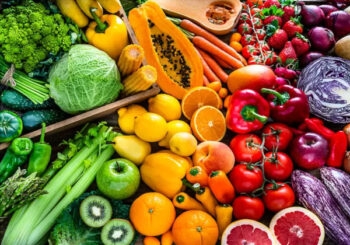By John Patterson
Staff Writer for Wake Up World
When we think about nutrition and performance, we often focus on physical strength and endurance. However, a recent study conducted by researchers from the University of Georgia has shed light on the impact of a colorful diet on athletes’ visual range. The findings suggest that incorporating a variety of fruits and vegetables into an athlete’s nutrition plan could significantly improve their ability to see targets clearly over distance.
Published in Exercise and Sport Sciences Reviews, the study delves into the role of macular pigments, which are plant compounds that accumulate in the retina, in promoting eye health and functional vision. These pigments, namely lutein and zeaxanthin, are found in abundance in dark leafy greens, as well as yellow and orange vegetables.
Lead author Jack Harth, a doctoral candidate in UGA’s College of Public Health, explains, “A lot of the research into macular lutein and zeaxanthin has focused on health benefits, but from a functional perspective, higher concentrations of these plant pigments improve many aspects of visual and cognitive ability. In this paper, we discuss their ability to improve vision in the far distance or visual range.”
Visual range plays a critical role in the performance of top athletes across various sports. The challenge of seeing objects clearly over distance is partly attributed to the effects of blue light. Harth elaborates, “From a center fielder’s perspective, if that ball’s coming up in the air, it will be seen against a background of bright blue sky, or against a gray background if it’s a cloudy day. Either way, the target is obscured by atmospheric interference coming into that path of the light.”
While athletes already employ measures like eye black or blue blocker sunglasses to mitigate the impact of blue light, consuming foods rich in lutein and zeaxanthin can enhance the eye’s natural ability to handle blue light exposure, according to Harth. When these compounds are absorbed, they accumulate as yellow pigments in the retina, acting as a filter to prevent excessive blue light from entering the eye.
The study builds upon previous research conducted in the 1980s that tested the visual range ability of pilots. More recent work by Billy R. Hammond and Lisa Renzi-Hammond, UGA researchers, has further explored the relationship between macular pigment density and various measures of eye health and functional vision tests. Hammond, the corresponding author and a professor of psychology in the Behavior and Brain Sciences Program at UGA’s Franklin College of Arts and Sciences, states, “In a long series of studies, we have shown that increasing amounts of lutein and zeaxanthin in the retina and brain decrease glare disability and discomfort and improve chromatic contrast and visual-motor reaction time, and supplementing these compounds facilitates executive functions like problem-solving and memory. All of these tasks are particularly important for athletes.”
By bringing the research on the links between macular pigment and functional vision up to date, Harth believes it’s now time to explore the implications for optimizing athletic performance. He shares, “We’re at a point where we can say we’ve seen visual range differences in pilots that match the differences found in modeling, and now, we’ve also seen it in laboratory tests, and a future goal would be to actually bring people outside and to measure their ability to see contrast over distance through real blue haze and in outdoor environments.”
However, before you rush to load up on kale and other nutrient-rich foods, Harth advises caution. Each individual’s absorption and utilization of lutein and zeaxanthin may vary, meaning it could take time to notice any improvements, if at all. Nonetheless, the overall health benefits associated with consuming more of these plant compounds are reason enough to add a splash of color to your diet.
Harth concludes, “We have data from modeling and empirical studies showing that higher macular pigment in your retina will improve your ability to see over distance. The application for athletes is clear.”
So, whether you’re an aspiring athlete or simply looking to enhance your visual range and overall eye health, consider incorporating a vibrant array of fruits and vegetables into your daily meals. By nourishing your body with lutein and zeaxanthin-rich foods, you may unlock the potential for sharper and clearer vision, helping you navigate the world with newfound clarity.
Reference:
- Jacob B. Harth, Lisa M. Renzi-Hammond, Billy R. Hammond. A Dietary Strategy for Optimizing the Visual Range of Athletes. Exercise and Sport Sciences Reviews, 2023; Publish Ahead of Print DOI: 10.1249/JES.0000000000000318
About the author:
John Patterson is an avid writer and researcher who delves into the latest scientific research. With an insatiable curiosity, he translates complex concepts into accessible narratives, allowing readers to embark on a journey of discovery. Through his work, John bridges the gap between experts and the public, igniting curiosity and inspiring meaningful conversations about scientific breakthroughs.

If you've found value in our articles, we invite you to support the release of our brand-new book, "Gratitude Practices for Kids: A Practical Guide for Adults to Instill a Spirit of Appreciation and Positivity in the Next Generation."
"Gratitude Practices for Kids" brings together over 25 innovative and accessible practices designed to enhance gratitude in everyday life. This comprehensive guide is backed by 17 scientific studies, ensuring each concept is grounded in research, underscoring our commitment to nurturing growth, emotional intelligence, and positive interactions between adults and children.
We encourage you to opt for the paperback version to celebrate this new release. Dive into its fresh pages away from digital distractions, allowing you to immerse yourself in the transformative practices it offers.
Over recent years, Wake Up World has faced significant online censorship, which has impacted our financial ability to operate. Moving into book publishing represents a strategic step to secure the ongoing funds needed to continue our mission. By purchasing Gratitude for Kids, you help us keep our content free and accessible to everyone, avoiding needing a paywall. With over 8,500 articles published in the last 13 years, we remain dedicated to keeping our valuable content open to all.









